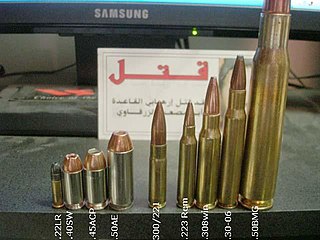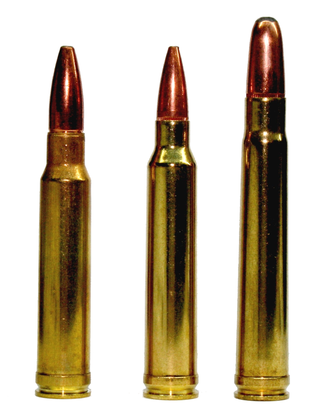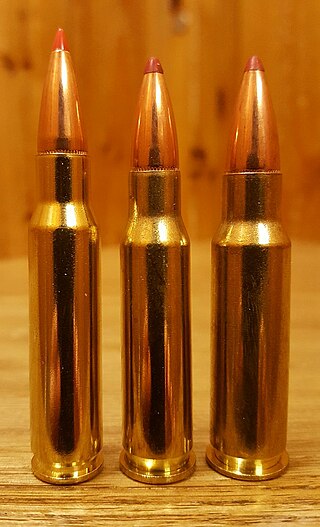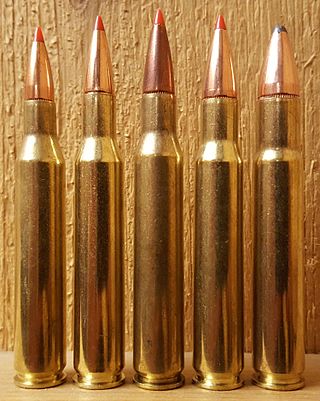Related Research Articles

The .308 Winchester is a smokeless powder rimless bottlenecked rifle cartridge widely used for hunting, target shooting, police, military, and personal protection applications globally. It is similar, but not identical, to the 7.62×51mm NATO cartridge.
The .510 Whisper is a subsonic rifle cartridge developed by SSK Industries for use in suppressed rifles. It is capable of firing a .51-caliber bullet weighing 750 gr (49 g) at roughly 1,050 ft/s (320 m/s).

The .300 Whisper (7.82x34mm) is a CIP standard cartridge in the Whisper family, a group of cartridges developed in the early 1990s by J.D. Jones of SSK Industries. It was developed as a multi-purpose cartridge, capable of utilizing relatively lightweight bullets at supersonic velocities as well as heavier bullets at subsonic velocities.

The 7mm-08 Remington is a rifle cartridge that is almost a direct copy of a wildcat cartridge developed around 1958 known as the 7mm/308. As these names would suggest, it is the .308 Winchester case necked down to accept 7 mm (.284) bullets with a small increase in case length. Of cartridges based upon the .308, it is the second most popular behind only the .243 Winchester. However, the .308 is more popular than both. In 1980, the Remington Arms company popularized the cartridge by applying its own name and offering it as a chambering for their Model 788 and Model 700 rifles, along with a limited-run series within their Model 7600 pump-action rifles during the early 2000s.

The .300 Winchester Magnum is a belted, bottlenecked magnum rifle cartridge that was introduced by the Winchester Repeating Arms Company in 1963. The .300 Winchester Magnum is a magnum cartridge designed to fit in a standard rifle action. It is based on the .375 H&H Magnum, which has been blown out, shortened, and necked down to accept a .30 caliber (7.62 mm) bullet.

The .444 Marlin (10.9×57mmR) is a rifle cartridge designed in 1964 by Marlin Firearms and Remington Arms. It was designed to fill in a gap left by the older .45-70 when that cartridge was not available in any new lever-action rifles; at the time it was the largest lever-action cartridge available. The .444 resembles a lengthened .44 Magnum and provides a significant increase in velocity. It is usually used in the Marlin 444 lever-action rifle. Currently, Marlin, who is now owned by Ruger Firearms, does not offer the .444 chambering in any of their rifles. It remains to be seen when or if they will bring the chambering back into production.
The Whisper family of firearm cartridges is a group of wildcat cartridges developed in the early 1990s by J.D. Jones of SSK Industries. The Whisper Family was developed as a line of accurate, multi-purpose cartridges using relatively heavy rifle bullets for a given caliber in subsonic loads. The intention was to create an extremely accurate cartridge family for military, police, competition and specialized hunting markets that could also be easily sound suppressed.

The 7mm Remington Magnum rifle cartridge was introduced as a commercially available round in 1962, along with the new Remington Model 700 bolt-action rifle. It is a member of the belted magnum family that is directly derived from the venerable .375 H&H Magnum. The original purpose of the belted magnum concept taken from the .300 H&H Magnum and .375 H&H Magnum, was to provide precise headspace control, since the sloping shoulders, while easing cartridge extraction, were unsuitable for this purpose. Improved cartridge extraction reliability is desirable while hunting dangerous game, in particular when a fast follow-up shot is required. The 7mm Remington Magnum is based on the commercial .264 Winchester Magnum, .338 Winchester Magnum, and .458 Winchester Magnum, which were based on the same belted .300 H&H Magnum and .375 H&H Magnum cases, trimmed to nearly the same length as the .270 Weatherby Magnum.

The 8mm Remington Magnum belted rifle cartridge was introduced by Remington Arms Company in 1978 as a new chambering for the model 700 BDL rifle. The 8mm Remington Magnum's parent case is the .375 H&H Magnum. It is a very long and powerful cartridge that cannot be used in standard length actions, such as those that accommodate the .30-06 Springfield.
The .264 Winchester Magnum is a belted, bottlenecked rifle cartridge. Except for the .244 H&H Magnum and .257 Weatherby Magnum, it is the smallest caliber factory cartridge derived from the 2.85 in (72 mm) Holland & Holland belted magnum case. It was introduced in the late 1950s and early 1960s with the .338 Winchester Magnum and the .458 Winchester Magnum as one of a family of short-cased 2.5 in (64 mm) belted magnum cartridges developed by Winchester based on the .375 Holland & Holland parent case. It was officially introduced to the public by Winchester in 1959. After many years of dwindling use it began enjoying a mild resurgence in popularity in the mid-2000s among long range rifle enthusiasts and reloaders due to the high ballistic coefficient of the heavier 6.5mm bullets and increasing popularity of cartridges such as 6.5mm Creedmoor, .260 Remington, 6.5 Grendel, benchrest and wildcat cartridges in 6.5mm.
The .260 Remington cartridge was introduced by Remington in 1997. Many wildcat cartridges based on the .308 Winchester case had existed for years before Remington standardized this round.

.22 caliber, or 5.6 mm caliber, refers to a common firearms bore diameter of 0.22 inch (5.6 mm).
The 7-30 Waters cartridge was originally a wildcat cartridge developed by author Ken Waters in 1976 to give better performance to lever-action rifle shooters than the parent .30-30 Winchester cartridge, by providing a higher velocity and flatter trajectory with a smaller, lighter bullet. By 1984, Winchester introduced a Model 94 rifle chambered for the 7-30 Waters, establishing it as a commercial cartridge. In 1986, Thompson/Center began chambering 10-inch, 14-inch, and 20-inch Contender barrels for the cartridge.

The .338 Marlin Express is a cartridge developed by Marlin Firearms and Hornady. It is based on the .376 Steyr with a goal to duplicate the venerable .30-06 Springfield's performance in a cartridge compatible with lever-action firearms. The cartridge uses a slightly shorter, rimmed case to function in lever-action rifles with tubular magazines. As introduced in Hornady's LEVERevolution line of cartridges, it follows the design logic of the .308 Marlin Express which preceded it. The .338MX fires heavier .338 caliber bullets than the .308 Marlin Express at roughly the same velocity. It is chambered in Marlin's Model 338MX and 338MXLR rifles using the Marlin Model 336 action.

.30-06 Springfield wildcat cartridges are cartridges developed from a 30-06 Springfield "parent cartridge" through narrowing or widening the cartridge neck to fit a smaller or larger bullet in an attempt to improve performance in specific areas. Such wildcat cartridges are not standardized with recognized small arms standardization bodies like the SAAMI and the CIP.
The .277 Wolverine (6.8x39mm) is a wildcat cartridge. It is a multi-purpose mid-power cartridge with increased ballistic performance over the AR-15's traditional .223 Remington cartridge. The use of a modified 5.56 case means that at minimum, only a new barrel is needed to convert any 5.56-based firearm to .277 Wolverine.
Nosler produces six different hunting cartridges. The first to be introduced was .26 Nosler, followed by .28 Nosler, .30 Nosler, .33 Nosler, .22 Nosler, and .27 Nosler.
The .500 Whisper or .500 Whisper Short Belted is a subsonic rifle cartridge developed by SSK Industries for use in suppressed rifles. It is capable of firing a .51-caliber bullet weighing 750 gr (49 g) at roughly 1,050 ft/s (320 m/s).
References
- 1 2
- Barnes, Frank C. (2006) [1965]. Skinner, Stan (ed.). Cartridges of the World (11th ed.). Iola, WI, USA: Gun Digest Books. pp. 252, 284. ISBN 0-89689-297-2.
- ↑ User "Review" on the .338 ammo
- 1 2 http://www.reloadersnest.com/frontpage.asp?CaliberID=389 Information on the two different whisper versions
